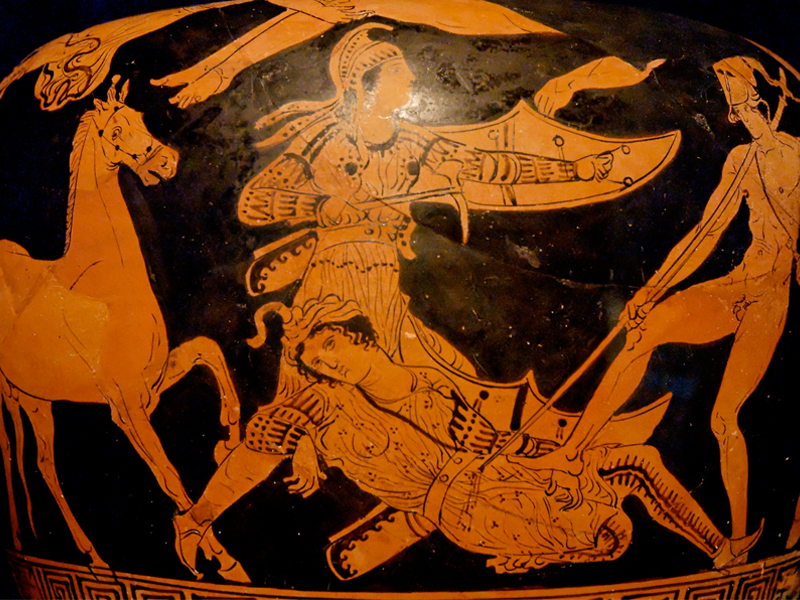By Adrienne Mayor
In Greek myth, Amazons were fierce women of exotic lands who gloried in hunting and war. The greatest Greek heroes, Heracles and Achilles, proved their valor by killing Amazon queens. But were Amazons mere fantasy? Thanks to archaeology, we now know they were modeled on real steppe nomads of Eurasia.
In the ancient Greek myths that made them famous, the Amazons were fierce warrior women dwelling on the fringes of the known world, around the Black Sea and beyond. The “equals of men”, Amazons were as courageous and skilled in battle as men. In Greek myths, these barbarian women gloried in outdoor life, sexual freedom, hunting, and warfare.
The greatest heroes of Greek myth – Heracles, Theseus, and Achilles – proved their valor by killing formidable Amazon queens. By the time Homer wrote the Iliad (about 650 BC), every Greek man, woman, and child knew thrilling Amazon tales by heart. Amazons wearing patterned trousers and boots, riding horses, shooting bows, swinging battle-axes, hurling spears, and dying heroically became wildly popular subjects in Greek vase paintings and sculptures. Vivid “Amazonomachies” (scenes of Amazon battles) decorated public buildings. In Greek art and literature, Amazons were invariably depicted as brave and beautiful, but always armed and dangerous (see figure 1 below).
 Fig 1. Achilles killing the Amazon Penthesilea at Troy, Lucanian vase painting ca 400 BC,
Fig 1. Achilles killing the Amazon Penthesilea at Troy, Lucanian vase painting ca 400 BC,
Siritide National Museum of Policoro, (Marie-Lan Nguyen).
Source: Figure 18.3 in Mayor, The Amazons: Lives and Legends of Warrior Women across the Ancient World (Princeton, 2014), used with permission
Were Amazons real? Or were the bold, war-loving women mere fantasy figures? Modern historians have long assumed that the world of Amazons was nothing but an elaborate fiction brought to life by the Greek storytelling imagination. But now, thanks to spectacular and recent archaeological discoveries, compelling evidence confirms that Amazons of myth were modeled on real warrior women of steppe tribes, known to the Greeks as “Scythians”. In antiquity, “Scythia” referred to the vast territory stretching from Ukraine and southern Russia to Kazakhstan and Mongolia, populated by numerous diverse but culturally related tribes of nomadic mounted archers. Flourishing between 700 BC and AD 500, the Scythian lifestyle centered on horses, archery, and constant warfare. So far, archaeologists have discovered more than 1,000 Scythian grave mounds (kurgans) containing human remains, rich golden artifacts and distinctive clothing, armor, and weapons (see map 1 below).
 Map 1. Ancient Scythia. Map by Michele Angel.
Map 1. Ancient Scythia. Map by Michele Angel.
The Greeks first encountered Scythians in the seventh century BC, as Hellenic city-states began to establish colonies around the Black Sea and traders ventured deeper into Central Asia. As Greek knowledge of Scythia expanded, descriptions and images of Amazons took on more and more realistic details, reflecting steppe nomad customs, attire, horses, bows, and quivers. By about 450 BC, Herodotus and other Greek historians were describing how women of Scythia “fought alongside the men on horseback, like Amazons of myth.” Ancient sources reported that Cyrus of Persia, Alexander the Great, and the Roman general Pompey – encountered Amazon-like warrior women in eastern lands.
Until the advent of DNA and bioarchaeological analysis, archaeologists of the past had routinely identified every skeleton buried with weapons as a male warrior. No longer. Today’s scientific testing is reversing the old assumptions that only men were warriors and that weapons were exclusively masculine possessions. The DNA analyses reveal that about one-third of Scythian females were active fighters. So far, 300 graves of women buried with spears, swords, battle-axes, and quivers of arrows have been reported, dating from the Bronze Age to the second century AD. Many of the armed female skeletons bear combat injuries, such as arrowheads embedded in bones, ribs slashed by swords, and skulls punctured by pointed battle-axes. Bioarchaeologists can even determine whether the women were in motion and fighting face-to-face on foot or on horseback, and whether they deflected enemy blows. Many of the women’s skeletons indicated a lifetime of hard riding and hands show heavy use of a bow (see map 2 below).
 Map 2. Archaeological discoveries of more than 300 warrior women burials
Map 2. Archaeological discoveries of more than 300 warrior women burials
in ancient Scythian lands. Map by Michele Angel.
The discovery of several frozen mummies in the Altai show that Scythian women and men were heavily tattooed. Some graves preserve wool, felt, silk, fur, and leather clothing. Men and women dressed alike in practical trousers, tunics, and boots – much like the Amazons depicted in Greek vase paintings. Women were buried with the same honors as men, with sacrificed horses and a great feast for the mourners. Like the males, women were accompanied by armor, weapons, tools, hemp-smoking equipment, and a ritual last meal – fermented mare’s milk and horsemeat impaled with an iron knife on a wooden plate. The youngest warrior girls with weapons were only 10 to 14 years old when they died, proof that nomad children were trained to ride horses and handle weapons at an early age. Notably, babies were buried with both men and women.
A typical example of a warrior woman burial dates to about 300 BC in Kazakhstan. She was buried holding her large iron dagger in her right hand. A nearby grave held a girl aged 14-15, with her quiver and 40 bronze arrowheads. One kurgan in Ukraine contained several female skeletons aged 10 to 45, laid to rest with armor, spears, and arrows (see figure 2 below).
 Fig 2. Typical warrior woman skeleton with large iron dagger and two iron arrowheads,
Fig 2. Typical warrior woman skeleton with large iron dagger and two iron arrowheads,
Scythian burial, 4th century BC, photo by James Vedder. Source: Color plate 3, in Mayor,
The Amazons: Lives and Legends of Warrior Women across the Ancient World (Princeton, 2014), used with permission.
Many armed women’s burials have come to light around Rostov-on-Don, Russia. For example, to make way for a new highway archaeologists excavated a kurgan of a young female of about 20. Surrounded by horse equipment, an iron battle-axe, and a Chinese mirror, she wore a diadem of golden birds and stags and a sumptuous turquoise and gold chest piece decorated with monkeys fighting dragons. Her grave goods combine Scythian and Asian motifs, testifying to the nomads’ far-ranging trade. She had been killed by an arrow.
The extensive archaeological evidence points to a level of gender equality that would have astonished the Greeks, whose wives and daughters stayed indoors weaving and minding children. In contrast, the nomadic horsemen and women lived a rugged life in a harsh landscape, always on the move, hunting, raiding and battling hostile tribes. Because every member of the tribe was a stakeholder, everyone contributed to survival. It made sense to train girls as well as boys to ride, shoot arrows, and make war. Indeed, in Scythia, the great equaliser for women was the combination of horses and archery. Astride a fast horse, a woman with a bow could be deadly as a man.
The egalitarian lifestyle of the Scythians was both exhilarating and daunting for the Greeks, who were inspired to create an outpouring of exciting narratives about barbarian women as brave and skilled in war as men. In their myths about Amazons, it seems that the Greeks permitted themselves a safe space to explore the idea of equality between the sexes, an impossible dream in the paternalistic Greek society.
The Greek mythic scenario doomed every Amazon queen to death at the hands of the invincible Greek national heroes. But later historical writers’ accounts of the campaigns and victories of warrior queens in barbarian lands were more realistic. One example was Tirgatao, leader of the Ixomatae in the Azov-Don region in the fifth century BC. Tirgatao, whose name means “Arrow Power,” fought enemies in the Caucasus with her army of male infantry archers and cavalrywomen skilled with bows and lariats. At one point Tirgatao was captured and locked in a tower, but she made a daring escape and returned to the Don River, raised another army, and took revenge. Another time, her armored war-belt deflected a blow from an opponent. About 300 years later, Amage (“Meadow”) was acclaimed ruler of the Roxolani, a tribe of Alan-Sarmatians. She also won many victories. In one incident, Amage led 120 of her best warriors in an attack and personally killed the enemy commander. She saved his son, however, and persuaded him to rule peacefully.
It is often assumed that the ancient Greeks held a monopoly on Amazons. But Greeks were not the only ancient culture to weave stories about warlike women and thrill to accounts of legendary and historical warrior queens. The tough horsewomen of the steppes also inspired oral traditions and writings in Egypt, Persia, Trans-Caucasia, Armenia, Azerbaijan, Iran, Central Asia, India, and even China.
The Persians encountered some powerful warrior queens of Scythia in their campaigns. The Saka-Scythian queen Sparethra (“Heroic Army”) commanded an army of about 300,000 horsemen and women against Cyrus the Great of Persia. As the Greek historian Diodorus remarked, the Saka were known for “courageous women who share with their men the dangers of war.” Sparethra defeated the Persian forces and captured three of Cyrus’s sons, forcing Cyrus to agree to a peace treaty.

Sparethra and Cyrus became allies. But Cyrus was not so lucky with Queen Tomyris of the Saka-Massagetae. In about 530 BC, Cyrus was routed by Tomyris’s horde of mounted archers. The Persian king resorted to treachery, setting up an ambush with wine as the bait. The nomads, unused to wine, were slaughtered and Tomyris’s son was captured. Enraged by the trick, Tomyris sent a message to Cyrus vowing to “give him his fill of blood.” In the next battle, amid horrendous mayhem, Tomyris’s army destroyed the Persians. Cyrus was mortally wounded. It was said that Tomyris found the king’s corpse, hacked off his head, and plunged it into a wine jug brimming with blood. Today Kazakhstan claims Tomyris as their national heroine and issues coins in her honor (see figure 3).
The life of another historical Saka queen inspired an ancient Persian (Iranian) romance. During the Median Empire (625–550 BC), the daring Zarina (“Golden”) conquered many foes. The Parthians requested that Zarina lead a revolt, setting off a series of wars between the Saka-Parthians and the Medes. In one battle, Zarina and the Mede commander Stryangaeus faced off. He knocked her from her horse but, struck by her bravery, allowed her to remount and escape. Some time later, Zarina captured Stryangaeus but freed him because the Mede had once saved her life. Later, after the Medes and the Saka declared peace, Stryangaeus visited Queen Zarina in Rhoxanake (“Shining City”) and declared undying love for his former enemy.
Some scholars have compared this Persian love story to the tragic Greek myth of Achilles who regretted killing the valiant Amazon Penthesilea at Troy. But the Persian tale offers a very different scenario. Zarina and Stryangaeus had spared each other’s lives in battle, and thus friendship and love were possible.
Several Circassian legends tell how an Amazon queen of the Caucasus, Valdusa, and her all-female band fought Circassian men led by Thulme. After many indecisive battles, the armies faced each other yet again on the plain. But this time, Valdusa requested a private meeting with Thulme. A tent was pitched between the armies and the leaders entered alone.
When the pair emerged the next day, Valdusa announced that they had decided to marry and would henceforth fight common enemies together as equals. The lovers asked their soldiers to follow their example. The women warriors invited the Circassian men to be their husbands. In all versions of the legend, the Circassians and the Amazons joined forces and rode to war as companions ever after. The legend recalls Herodotus’s earlier account of a band of Amazons skirmishing with Scythian men and then deciding to elope and form the Sarmatians.
A recently discovered ancient Egyptian papyrus describes a similar happy ending. An Amazon queen of Syria, Serpot (“Blue Lotus”), fights an Egyptian commander, Pedikhons, in single combat. They are so well matched that neither can win. After several duels, they fall in love, decide to join forces, and march off to fight foes together (see figure 4 on right).
Other plots in which equally matched male and female warriors become companions in love and war are found in the ancient traditions of Central Asia and even China. Examples are the Kalmyk warrior-heroine Saikal and the hero Manas, in the Manas epic, a compendium of Kyrgyz, Kazakh, Nogay, Uighur, and Turkic legends recited by generations of bards. In Uzbek and Kyrgyz poems about the Forty Maidens, from her citadel on the Aral Sea, Gulaim defeats a cruel Kalmyk leader in single combat and allies with the hero Aryslan of another tribe. They become lovers and form a coalition of Karakalpaks, Turkomans, Uzbeks, and Kazakhs, winning many more victories. Similar storylines appear in Chinese folk ballads about nomadic warrior women of Inner Asia.
These non-Greek tales diverge radically from the dark mythic script of Greece, in which Amazon queens always suffered tragic fates. While the idea of women as men’s equals evoked emotions of awe and dread in the Greek myths, the idea of courageous, autonomous women aroused a desire for alliances and romantic companionship in other ancient cultures that came in contact with real warrior women. Outside of Greek myth, warrior women could survive battles, win victories, fall in love, and sometimes even live happily ever after.
About the Author
 Adrienne Mayor, a research scholar in Classics and History of Science at Stanford University since 2006, is the author of five books, translated into ten languages, including The Amazons: Lives and Legends of Warrior Women across the Ancient World (Princeton, 2014) and a biography of Mithradates VI of Pontus, The Poison King, a nonfiction finalist for the 2010 National Book Award.
Adrienne Mayor, a research scholar in Classics and History of Science at Stanford University since 2006, is the author of five books, translated into ten languages, including The Amazons: Lives and Legends of Warrior Women across the Ancient World (Princeton, 2014) and a biography of Mithradates VI of Pontus, The Poison King, a nonfiction finalist for the 2010 National Book Award.

































































